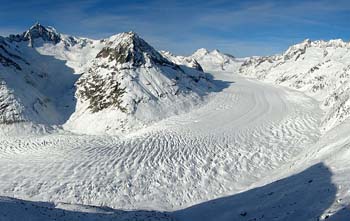Climate change threatens the world's glaciers, which is why scientists simulate them on computers. Based on mathematical models, these computer simulations help predict how glaciers are likely to change in the future, depending on environmental factors.

The Aletsch glacier in Switzerland.
But you can also run these simulations backwards in time, to see how a glacier behaved in the past. This is what a mathematician and a glaciologist have just done, not in order to understand glaciers, but in order to solve a mystery. In March 1926 four young men, three of whom were brothers, set off on a tour from the Aletsch glacier in Switzerland, the longest glacier in the Alps. They never returned. It's likely they got caught up in a blizzard that raged in the mountains for several days. Despite an extensive search their bodies could not be found and nobody knew where on their trip they met their end. Eighty-six years later, in the summer of 2012, two English alpinists found the remains of the three brothers and some of their equipment.
The mathematician Guillaume Jouvet of Freie Universität Berlin and the glaciologist Martin Funk of the ETH in Zürich realised that they could use a computer model of glaciers, which Jouvet had developed during his PhD in 2012, to find out where the men had met their death. The model was the first to represent the three-dimensional flow of a glacier, including the velocity of the flow beneath its surface. Starting from the place the men's bones were found, the scientists simulated the evolution of the glacier backwards in time. They found that the bodies probably moved by around 10.5km in the 86 years since they had been swallowed by the ice, at an average speed of 122 meters per year. In 1980 they were buried some 250m below the surface of the ice. And the place of the men's demise could be narrowed down to an area of 1600m by 300m.
Jouvet and Funk hope that they can solve other glacial mysteries using their method. For example, in 1964 a plane carrying US military crashed on the Gauli glacier in Switzerland. Crew and passengers could be rescued, but the plane disappeared in the ice without a trace. Using their model, Juvet and Funk hope to predict when and where it will be released from the ice. And who knows what other icy stories their model will reveal in the future.
Jouvet and Funk's work on the young men who died in 1926 has been published in the Journal of Glaciology. Thanks to our friend Thomas Vogt of the German Mathematical Association for bringing this story to our attention. You can read more about maths, ice and snow here on Plus.